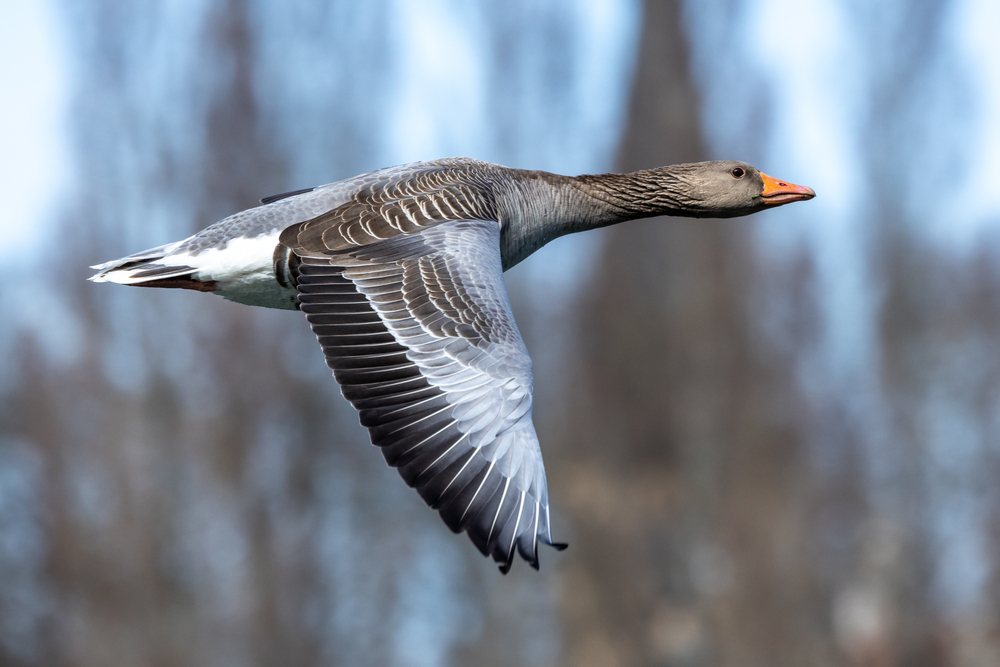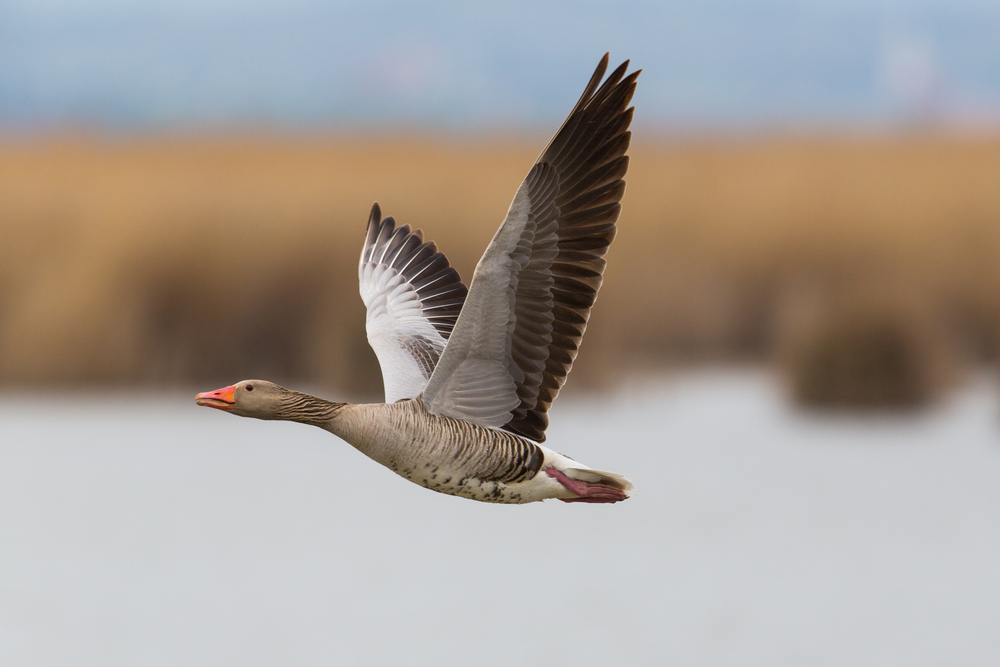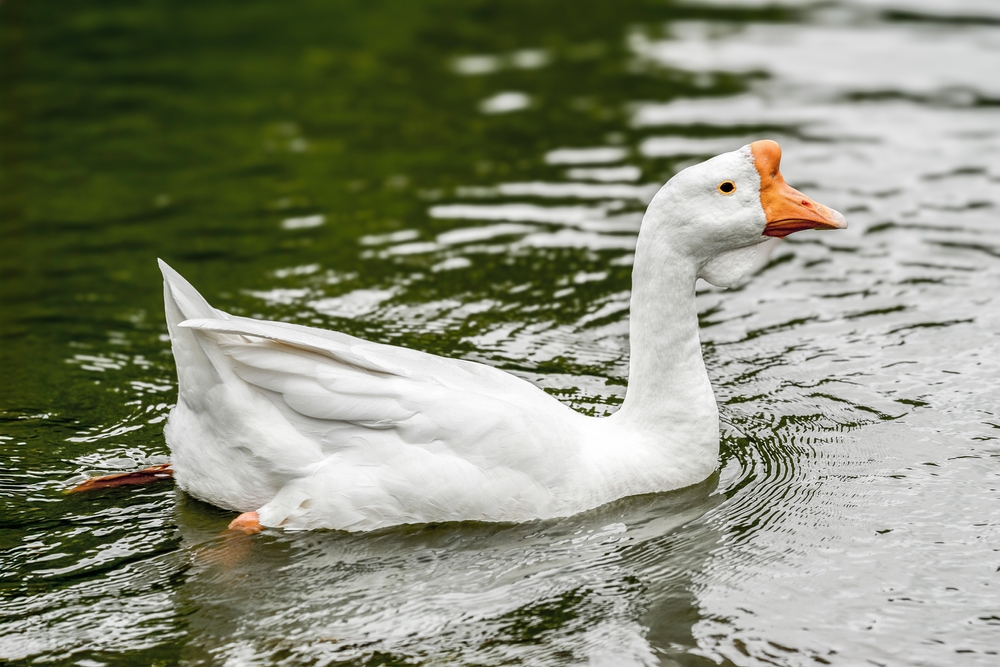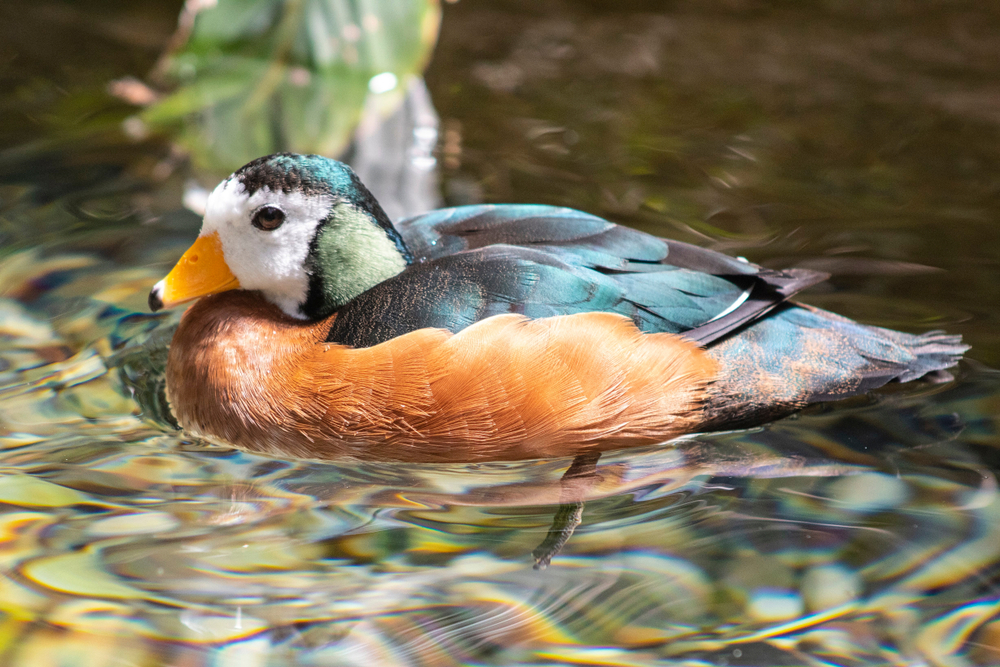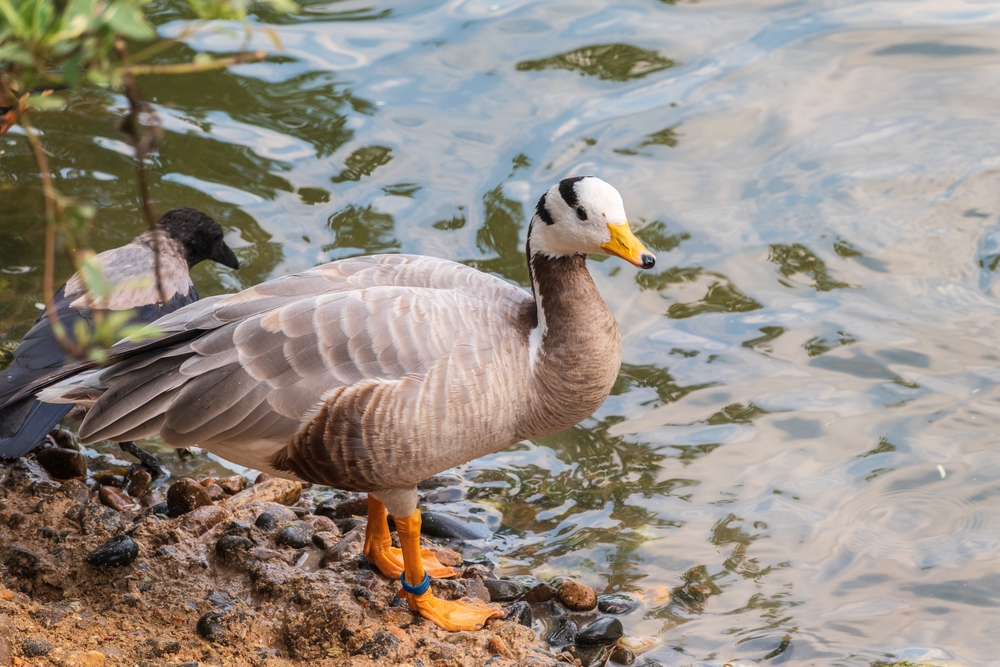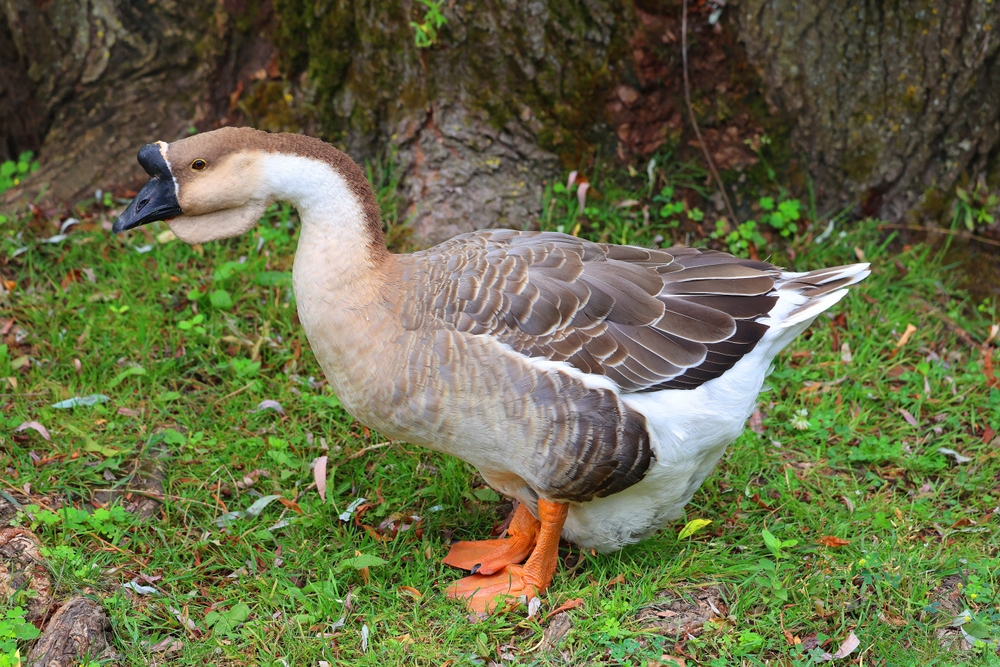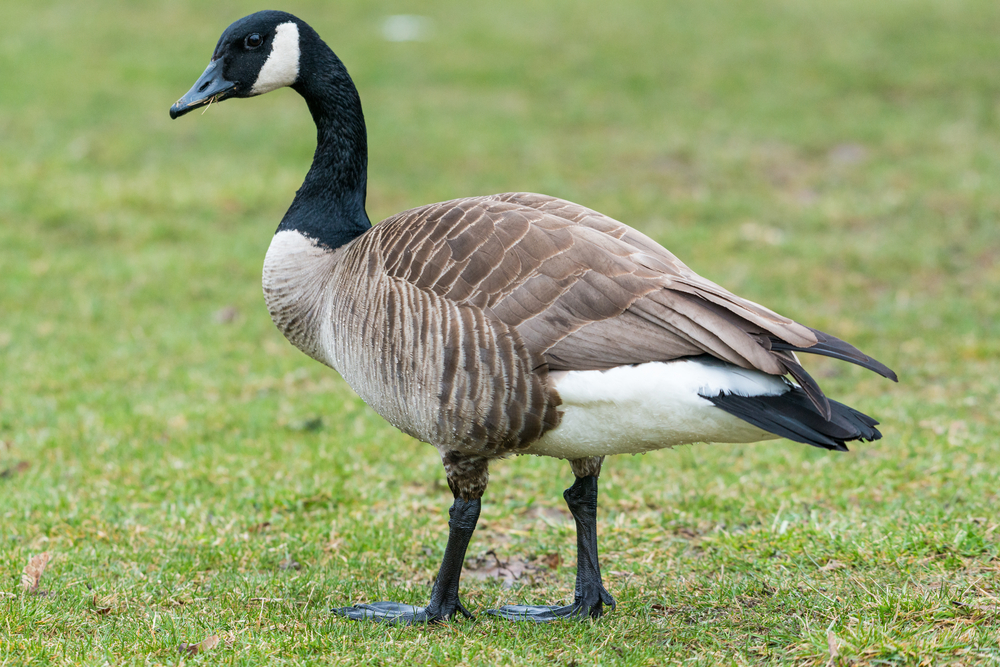Its closest relatives are other members of the genus Anser, especially the Bean Goose (Anser fabalis) and the Pink-footed Goose (Anser brachyrhynchus). The Greylag is also the direct ancestor of most domestic goose breeds.
About
The Greylag Goose (Anser anser), often referred to simply as the Grey Goose, is a large wild goose of the Anatidaefamily and the ancestor of most domestic goose breeds. Native to Europe and Asia, it is one of the most widespread goose species, inhabiting wetlands, lakes, marshes, grasslands, and agricultural fields. Its adaptability to both wild and human-modified landscapes has made it a familiar and iconic waterfowl across its range.
The Greylag Goose is among the largest of the wild geese, measuring 74 to 91 centimeters (29 to 36 inches) in length with a wingspan of 147 to 180 centimeters (58 to 71 inches). It has a bulky body, pale grey-brown plumage, a stout pink or orange bill, and pink legs. Its name “Greylag” comes from its overall grey coloration and its tendency to lag behind other geese during migration in some regions.
These geese are primarily herbivores, feeding on grasses, roots, seeds, and agricultural crops. Their grazing habits make them important ecological agents in grassland management, though they sometimes cause conflicts with farmers when feeding in large flocks.
Greylag Geese breed in wetlands, often near lakes or rivers, building nests on the ground concealed in reeds or vegetation. A typical clutch consists of four to six eggs, with the female incubating while the male guards the nest. Goslings are precocial, leaving the nest within a day to feed under the protection of their parents.
The species is partially migratory, with northern populations traveling south to winter in southern Europe, North Africa, and parts of Asia, while many in milder climates remain year-round. It is currently listed as Least Concern, with healthy and stable populations.
As the wild ancestor of domestic geese, the Greylag Goose holds cultural and agricultural importance, symbolizing abundance and tradition while remaining a vital part of Europe’s natural wetlands.
Physical Characteristics
The Greylag Goose is the largest and bulkiest of the wild gray geese of Europe and Asia, and it is the wild ancestor of most domestic geese, including the White Goose.
Plumage: Its plumage is predominantly gray-brown, with a paler belly and flanks. The back and wings show barred gray and brown patterns, while the underparts are lighter, often whitish. The head and neck are a uniform gray-brown, blending smoothly with the body.
Head & Beak: The head is broad with a large, strong, triangular orange or pink bill, depending on the population. The eyes are brown, surrounded by a thin pale orbital ring.
Body & Wings: The body is heavy and barrel-shaped, with a relatively long neck. The wings are broad and powerful, allowing strong migratory flight. The tail is short and rounded, tipped with white, and the legs and feet are orange-pink.
Size:
-
Length (Body and Tail): 29–36 in (74–91 cm)
-
Wingspan: 58–71 in (147–180 cm)
-
Tail Length: 6–7 in (15–18 cm)
Weight:
-
Adult Male: 6.6–10.1 lbs (3–4.6 kg)
-
Adult Female: 5.5–8.8 lbs (2.5–4 kg)
The Greylag Goose’s gray-brown plumage, orange or pink bill, and sturdy build distinguish it from darker Branta geese and from domesticated breeds. Its role as the progenitor of most domestic geese links it directly to both wild heritage and human culture.
Reproduction
The Greylag Goose follows a well-defined breeding cycle typical of large migratory geese, with strong pair bonds and devoted parental care.
1. Mating and Courtship:
Greylag Geese are monogamous, usually forming lifelong pair bonds. Courtship displays include head dipping, mutual calling, and synchronized swimming or flying. Established pairs often return to the same nesting areas annually.
2. Breeding Season:
Breeding occurs in spring (April–June), depending on latitude. Northern populations breed later as ice and snow retreat, while southern populations may start earlier.
3. Nesting:
Nests are built on the ground near water—marshes, reedbeds, islands, or lake shores. The female constructs a shallow depression lined with grasses, reeds, and soft down plucked from her breast.
4. Egg Laying and Incubation:
The female lays 4–6 large, white to creamy eggs, sometimes more in optimal conditions. Incubation lasts 27–28 daysand is performed solely by the female, while the gander guards the nest and territory.
5. Hatching and Chick Development:
Chicks are precocial, covered in yellow down and able to walk and swim within hours of hatching. Both parents lead them to feeding grounds, where they graze on tender grasses. Parents are vigilant protectors, using loud calls and aggressive displays to deter predators.
6. Fledging:
Goslings grow quickly and fledge at 8–9 weeks, though they remain with their family group for their first migration, learning routes and feeding strategies.
7. Sexual Maturity:
Greylag Geese reach breeding age at about 2–3 years, when they begin forming their own pair bonds and establishing nesting territories.
The Greylag Goose’s devoted parenting and long-term pair bonds, combined with its ground-nesting habits in wetland areas, have influenced the reproductive patterns of many domestic goose breeds derived from it.
Lifespan
The Greylag Goose is a long-lived species, with its survival shaped by natural predation, migration challenges, and human interaction.
Lifespan in the Wild:
In natural conditions, Greylag Geese typically live 10–15 years, though some individuals may survive up to 20 years. High mortality in the first year reduces average survival, but adults that reach maturity often live well over a decade.
Lifespan in Captivity:
In aviaries, farms, or managed reserves, Greylag Geese can live 20–30 years due to consistent food supply, protection from predators, and veterinary care. Some have been recorded living nearly three decades.
Threats to the Greylag Goose:
-
Predation: Eggs and chicks are vulnerable to foxes, gulls, crows, and raptors.
-
Hunting: In many regions, Greylags are legally hunted, reducing adult survival.
-
Habitat Loss: Drainage of wetlands and disturbance of breeding grounds impact populations.
-
Migration Risks: Long-distance flights expose them to exhaustion, storms, and hunting along routes.
Conservation Status:
The Greylag Goose is classified as a species of Least Concern by the IUCN, with stable or increasing populations in many areas thanks to hunting controls, protected wetlands, and adaptability to farmland habitats.
Eating Habits
The Greylag Goose is an herbivorous grazer and browser, with a flexible diet that shifts between wetlands, pastures, and agricultural fields.
Diet:
Its primary food sources include grasses, roots, shoots, leaves, seeds, and aquatic plants. In farmland areas, it readily feeds on barley, wheat, oats, and potatoes, sometimes making it unpopular with farmers.
Foraging Strategy:
Greylags graze by cropping grass close to the ground with their broad, strong bills. In shallow water, they dabble and upend to reach submerged plants. They also dig with their bills to pull up roots and tubers.
Feeding Behavior:
They are highly social feeders, often foraging in flocks that provide safety in numbers. Feeding is usually concentrated in early morning and late afternoon, with midday devoted to resting and preening.
Feeding Young:
Goslings begin grazing on tender grasses within hours of hatching. Parents guide them to safe, food-rich areas, though goslings feed themselves independently.
Seasonal Feeding:
-
Spring and Summer: Fresh grasses, shoots, sedges, and aquatic vegetation dominate the diet.
-
Autumn and Winter: They shift to agricultural crops, seeds, and root vegetables when natural forage is scarce.
Ecological Role:
By grazing, Greylag Geese help shape wetland vegetation and grassland dynamics. However, large flocks in farmland can cause crop damage, creating conflicts with agriculture.
The Greylag Goose’s adaptable diet and efficient grazing habits make it successful across a wide range of habitats, from wild marshlands to cultivated fields.
Uniqueness
The Greylag Goose is notable not only for its role in nature but also for its deep connection to human history and domestication:
Wild Ancestor of Domestic Geese: It is the primary wild ancestor of most domestic goose breeds in Europe and North America, making it one of the most significant species in human agricultural history.
Distinctive Appearance: Its orange or pink bill, bulky gray-brown body, and white-edged tail make it easily recognizable among wild geese.
Vocal Nature: The species is extremely vocal, with loud honking calls that serve as communication within flocks. These sounds have made Greylag Geese a cultural symbol of loyalty and vigilance.
Strong Pair Bonds: They are monogamous, often pairing for life, and are known for strong family bonds, migrating in family groups that remain together for months.
Migratory Versatility: Northern populations are strong migrants, traveling long distances to wintering grounds, while some southern populations are largely sedentary, showing adaptability to local conditions.
Cultural Significance: In ancient Greece and Rome, geese were kept for food, feathers, and as guardians. Roman legend tells that sacred geese of Juno warned the city of Rome of a Gallic invasion.
Adaptive Feeding: Its ability to thrive on both wild plants and agricultural crops has helped it expand into human-dominated landscapes, sometimes leading to population growth in areas where farmland is abundant.
The Greylag Goose’s combination of ecological adaptability, cultural legacy, and status as the foundation of domestic goose breeds makes it one of the most unique and historically important geese in the world.
Be the First to Share Photos of This Species.
FAQ’s
1. What is the closest species to the Greylag Goose?
2. How does the Greylag Goose compare to other geese?
It is larger and bulkier than the White-fronted Goose and shorter-necked than the Swan Goose. Unlike the black-and-white Branta geese, the Greylag has a softer gray-brown plumage. Its adaptability to both wetlands and farmland makes it more closely tied to human landscapes than many other wild geese.
3. What national parks provide the best opportunities to see a Greylag Goose?
What national parks provide the best opportunities to see a Greylag Goose?
-
Doñana National Park, Spain – Major wintering site for large flocks.
-
Wadden Sea National Parks (Netherlands, Germany, Denmark) – Important stopover and wintering grounds.
-
Loch Lomond & The Trossachs National Park, Scotland – Breeding and wintering populations.
-
Neusiedler See–Seewinkel National Park, Austria/Hungary – Strongholds in reedbeds and wetlands.
-
Danube Delta Biosphere Reserve, Romania – Large concentrations during migration.



































































